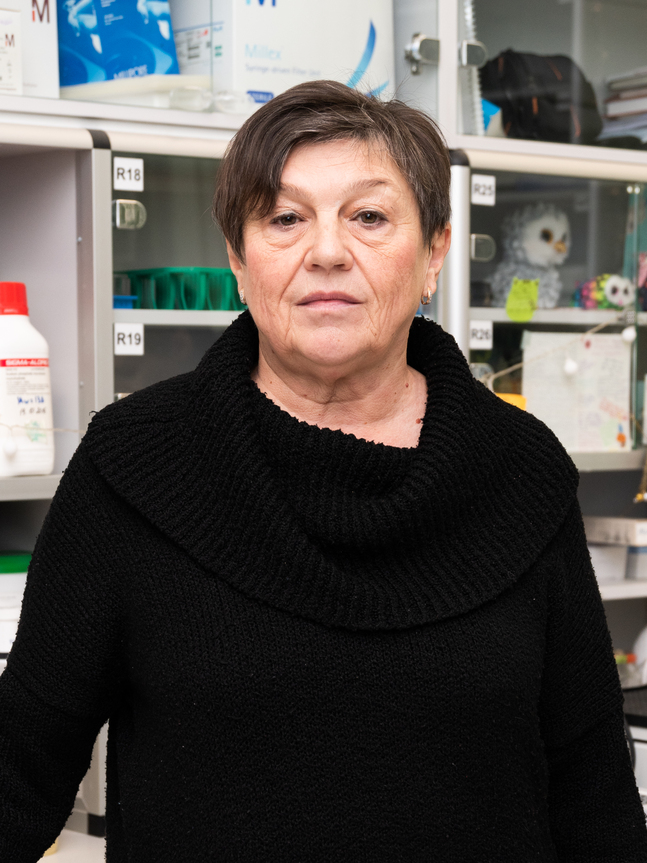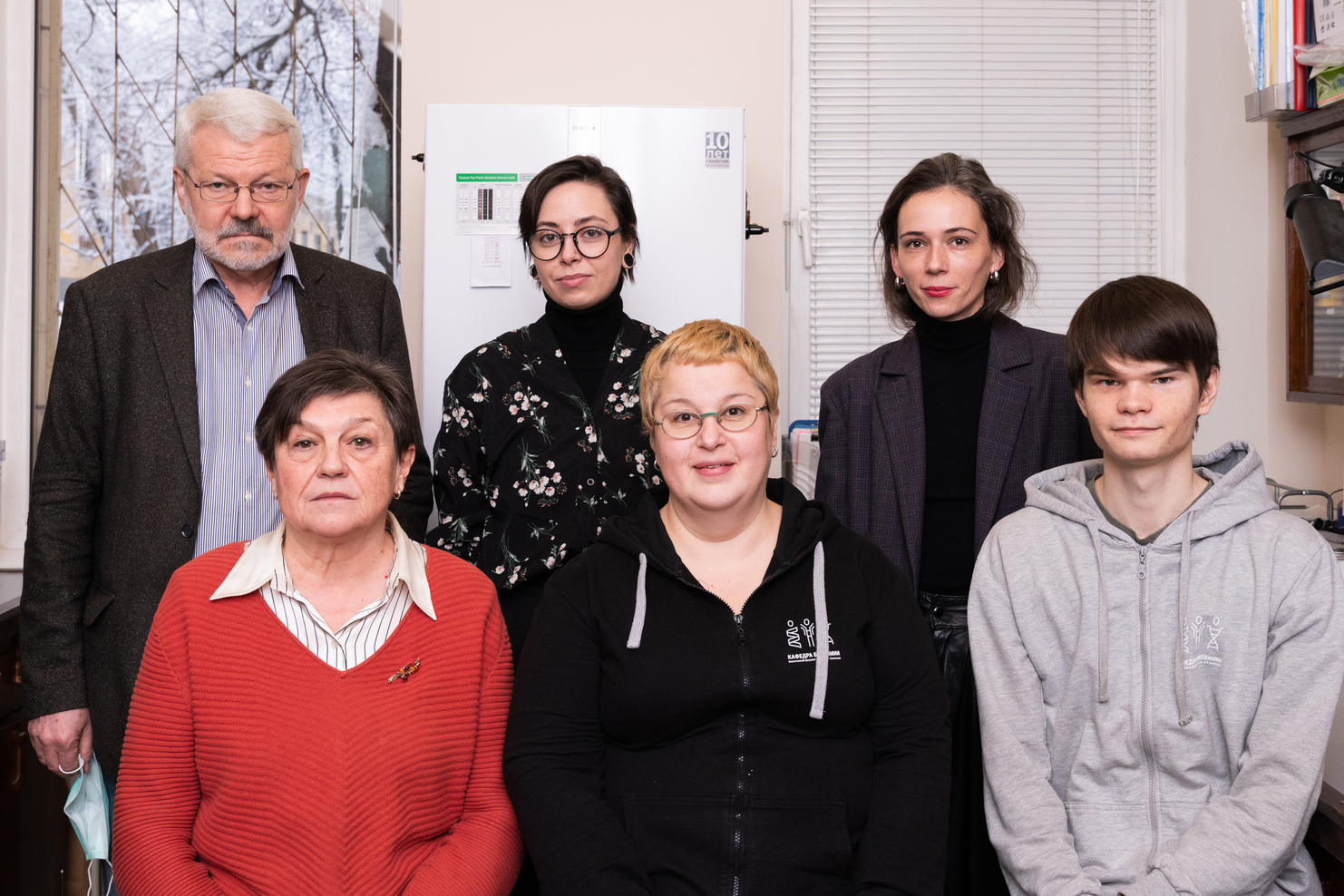Na,K-ATPase and its role in signal transduction

Na,K-ATPase (Na-pump) is an integral enzyme of plasma membrane that provides transportation of Na and K ions through the membrane against the electrochemical gradient. This enzyme was discovered by Jens Skou in 1957. In 1997, the work of Jens Skou devoted to discovery and the study of Na,K-ATPase was culminated in the Nobel Prize.
Investigation of Na,K-ATPase was started in our Department in 1967 under the guidance of professor A.A. Boldyrev. The investigations of our group are directed on the nonclassical functions of Na,K-ATPase. It was shown that Na,K-ATPase plays an important role in providing many cell functions: resting potential is created as a result of Na-pump work, the pump participates in the generation of action potential in excitable tissues, transmembrane potential created by Na-pump is used as energy source for the active secondary transport of some cations and metabolites (carbohydrates, aminoacids). It was also found that Na,K-ATPase serves as a receptor for cardiotonic steroids. Among these compounds, the well-known ones are ouabain and digoxin (alkaloid from foxglove). Recently it was shown that these compounds are presented not only in plants but also in animals where they serve as hormones.
Being bind to Na,K-ATPase cardiotonic steroids inhibit this enzyme. Enzyme inhibition in heart muscle results in the increase of intracellular Na+ concentration and in the activation of Na/Ca- exchanger that increases Ca influx into the cell. This, in turn, increases heart muscle contraction. But simultaneously, ouabain binding provides conformational change of Na,K-ATPase. This leads to the binding of Src-kinase to the enzyme which is activated. After that, Src-kinase phosphorylates epidermal growth factor and activates small GTP-binding proteins that turn on signal cascade affecting genes expression that, in turn, lead to hypertrophy of heart muscle.
Another situation is observed in kidney epithelial cells: ouabain binding to Na,K-ATPase resulted in cell death that is not connected with Na,K-ATPase inhibition. It is due to the conformational change of the enzyme and to the following binding to the enzyme of signal cascade proteins that in turn results in the activation of P38 MAP-kinase and to the cell death. Another cardiotonic steroids marinobufagenin does not induce cell death nevertheless it inhibits Na,K-ATPase. So, ouabain binding to Na,K-ATPase results in the providing of nonclassical function of the enzyme that consist in the turning-on signal cascades.
To date, our group is involved in the study of Na,K-ATPase conformational changes that are induced by the binding of ouabain and marinobufagenin with the goal of revealing enzyme coformation that is necessary to biding of protein inducing turning-on of signal cascade providing cell death. We also try to identify a protein that turn on signal cascade after binding to Na,K-ATPase in kidney epithelial cells.
The second direction of our investigations is connected with the study of glutationylation of Na,K-ATPase SH-group. Intracellular peptide glutation exists in the cell in two forms: oxidated and reducted. The ratio between oxidated and reduced glutation determinates redox-status of the cell: it falls under the condition of oxidative stress because the concentration of oxidated glutation increases. We found that the increase of oxidized glutation concentration leads to its binding to 13 of 15 cytosol SH-groups of catalytic subunit of Na,K-ATPase. Modification of three SH-groups located in a close proximity to enzyme active site results in complete loss of its activity. However, enzyme activity may be completely restored after the elimination of oxidative stress through the removal of glutation from corresponding SH-groups. This process plays an important role, because Na,K-ATPase consumes up to 40% of total amount of ATP in cardiomyocytes. In this way, glutationylation of SH-groups that are essential for the Na,K-ATPase activity may decrease ATP consuming that is important under hypoxia conditions.
The functions of other SH-groups of Na,K-ATPase and the role of their glutationylation are not fully investigated yet. We suggest that glutationylation of other SH-group of enzyme may be important in the regulation of some ligands binding, for example, regulatory proteins or cardiotonic steroids that may result in some signal cascades regulating. Six PhD theses were defended in the group. To date, there are two postgraduate students in the group: Elizabeth Klimanova and Elena Dergousiva, and research worker Julia Kamanina. During the last 20 years, investigation of our group were supported by RFBR grants and by international grants (Soros grants and INTAS grants). Our group works in the collaboration with the University of Montrel, Canada (professor S.N. Orlov), and with the Engelgardt Institute of Molecular Biology, Moscow, Russia (Laboratory of conformational stability of proteins and physical methods of analysis, under the guidance of academician A.A. Makarov).
Key publications
- Fedorov, D. A., Sidorenko, S. V., Yusipovich, A. I., Bukach, O. V., Gorbunov, A. M., Lopina, O. D., and Klimanova, E. A. Increased extracellular sodium concentration as a factor regulating gene expression in endothelium. Biochemistry (Moscow) 87, 6 (2022), 489–499.
- Lopina, O. D., Bukach, O. V., Sidorenko, S. V., and Klimanova, E. A. Na,k-atpase as a polyfunctional protein. Biochemistry (Moscow), Supplement Series A: Membrane and Cell Biology 16, 3 (2022), 207–216.
- Fedorov, D. A., Sidorenko, S. V., Yusipovich, A. I., Parshina, E. Y., Tverskoi, A. M., Abramicheva, P. A., Maksimov, G. V., Orlov, S. N., Lopina, O. D., and Klimanova, E. A. Na+i/k+i imbalance contributes to gene expression in endothelial cells exposed to elevated nacl. Heliyon 7, 9 (2021), e08088.
- Orlov, S. N., Tverskoi, A. M., Sidorenko, S. V., Smolyaninova, L. V., Lopina, O. D., Dulin, N. O., and Klimanova, E. A. Na,k-atpase as a target for endogenous cardiotonic steroids: what’s the evidence? Genes & Diseases 8 (2021), 259–271.
- Tverskoi, А. M., Poluektov, Y. M., Klimanova, E. A., Mitkevich, V. A., Makarov, A. A., Orlov, S. N., Petrushanko, I. Y., and Lopina, О. D. Depth of the steroid core location determines the mode of na,k-atpase inhibition by cardiotonic steroids. International Journal of Molecular Sciences 22, 24 (2021).
- Tverskoi A.M., Lokteva V.A., Orlov S.N., Lopina O.D. Binding of Ouabain, Digoxin, or Marinobufagenin Induces Different Сonformational Changes in Kidney α1-Na+,K+-ATPase Isoforms, Resistant and Sensitive to Cardiotonic Steroids. Biochemistry (Moscow), Supplement Series A: Membrane and Cell Biology 14 (2020)
- Klimanova E.A., Fedorov D.A., Sidorenko S.V., Abramicheva P.A., Lopina O.D., Orlov S.N. Ouabain and Marinobufagenin: Physiological Effects on Human Epithelial and Endothelial Cells. Biochemistry (Moscow) 85, 4 (2020), P. 507-515
- Lopina O.D., Tverskoi A.M., Klimanova E.A., Sidorenko S.V., Orlov S.N. Ouabain-induced cell death and survival. Role of a1-Na,K-ATPase-mediated signaling and [Na+]i/[K+]i-dependent gene expression. Frontiers in physiology (2020)
- Klimanova E.A., Sidorenko S.V., Abramicheva P.A., Tverskoi A.M., Orlov S.N., Lopina O.D. Transcriptomic Changes in Endothelial Cells Triggered by Na,K-ATPase Inhibition: A Search for Upstream Na+i/K+i Sensitive Genes. International Journal of Molecular Sciences 21, 21 (2020)
- Klimanova E.A., Sidorenko S.V., Smolyaninova L.V., Kapilevich L.V., Gusakova S.V., Lopina O.D., Orlov S.N. Ubiquitous and cell type-specific transcriptomic changes triggered by dissipation of monovalent cation gradients in rodent cells: Physiological and pathophysiological implications. Current topics in membranes 83 (2019), 107-149
- Poluektov Yuri M., Dergousova Elena A., Lopina Olga D., Mitkevich Vladimir A., Makarov Alexander A., Petrushanko Irina Yu. Na,K-ATPase alpha-subunit conformation determines glutathionylation efficiency. Biochemical and Biophysical Research Communications 510, 1 (2019), 86-90
Members of the group
| Group leader | professor, O.D. Lopina |
| Senior lecturer | E.A. Klimanova |
| Researcher | S.V. Sidorenko O.V. Bukach |
| Post-graduate students | D.A. Fedorov |
| Graduate student | A.M. Gorbunov |
